#drawing is based on bogart & bacall
Text
Today's Black History Month illustration is of Paul R. Williams, the first Black member of the American Institute of Architects.

Paul Revere Williams was born in Los Angeles in 1894 and was orphaned at four years old. Immediately after high school, he landed internships and jobs at local architecture firms despite the racial prejudice. Williams took classes at the Los Angeles Beaux-Arts School and then attended USC’s School of Engineering. He became a certified architect in 1915.
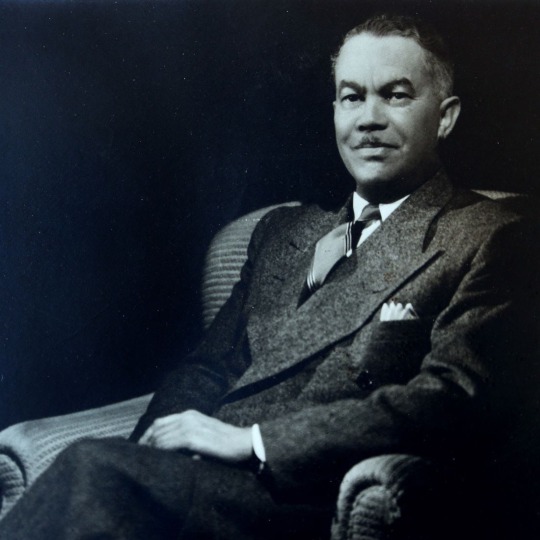
In 1920, Williiams was appointed to the first Los Angeles City Planning Commission, and the year after, he received a license to practice architecture in California and started working for John C. Austin. In 1922, he opened his own firm and served as an architect for the Navy during WWII. In 1923, Williams became the first Black person inducted into the American Institute of Architects.
He was an outstanding draftsman, and had the skill of rendering drawings upside down. He developed the skill so that his white clients (who might have been uncomfortable sitting next to a black architect) could see his drawings right side up across the table from him.
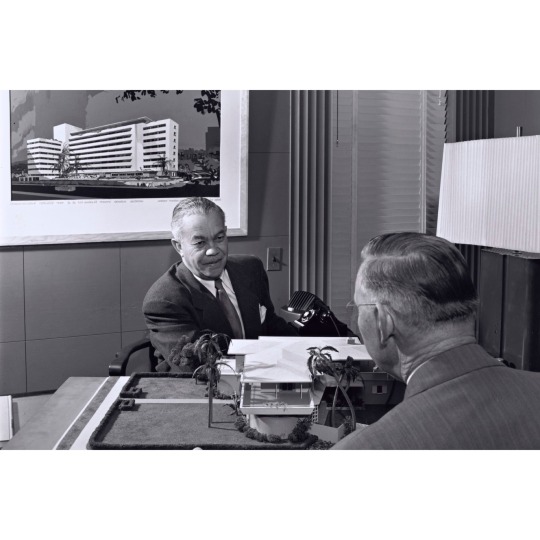
Williams designed over 2,000 homes, including the homes of Lucille Ball & Desi Arnaz, Frank Sinatra, Cary Grant, Humphrey Bogart and Lauren Bacall.

Along with designing homes for the wealthy and the stars, he designed affordable homes, public housing, civic, commercial and institutional buildings. Williams was also part of the Los Angeles International Airport (LAX) planning and design team.

Some of his works include the Golden State Mutual Life building in LA, St. Jude Children’s Hospital in Memphis, and the Los Angeles Superior Court.

He spearheaded the redesign of the Beverly Hills Hotel, a renovation which cost $3 million. The cursive letters on its sign are based on his own handwriting. Outside of LA, he remodeled buildings and spaces for Howard University (dentistry school, architecture and engineering college.)

He received many awards including the NAACP Spingarn Medal and USC’s Distinguished Alumni Award. In 1957, he became the first African American to become an AIA Fellow. In 2017, Williams was posthumously awarded the AIA Gold Medal, America’s highest honor for an architect. He was the first Black architect to receive the Gold Medal.

Williams passed away in 1980 at 85, leaving a mark on West Coast architecture and aspiring Black architects.

I’ll be back tomorrow with another illustration and story!
#paul r. williams#black history matters#black history month 2023#black history facts#artists on tumblr#illustrators on tumblr
108 notes
·
View notes
Text
WIP Wednesday (?)
Thank you for the tag @varric-tethras-editor!
This is from the next chapter of my DA:I 1930′s murder mystery AU (which I am well aware is an offensively absurd concept but I have nothing else to offer) + an art WIP. I’m also kantrips on AO3 if you want to have a gander at the first three chapters!
---------------------------------------------------------------------------
“I didn’t think…” Cullen trailed off.
Evelyn let out a derisive sound and began to work at the tight lid of the piccalilli jar. “No. You didn’t.” Her voice was strained as she began to struggle with the jar, her nose scrunching with the effort. “I used to think you understood me best of anyone but recently I’m beginning to feel like you don’t know me at all.”
“You’re shutting me out.”
“And you’re assuming the worst,” she told him, voice increasingly faint from the effort, but the lid wouldn’t budge.
Growing agitated watching her, Cullen reached for the jar. “Give it to me.”
She twisted away from him. “No!”
“For Andraste’s sake Evelyn, stop being stubborn and let me do it.”
Evelyn gave the lid a final wrench and it popped off. A shared moment of surprise disrupted both of their mounting animosity, but only fleetingly before they remembered themselves and it descended once more in full force. Evelyn glared at his still outstretched hand. Cullen retracted it. “I don’t need anything from you.”
“You’ve misunderstood my intentions,” Cullen rationalised, desperate to get the conversation back on track and making a concerted effort to keep his voice even.
“So I’m in the wrong again? Good to know.”
He let out an incomprehensible noise of frustration. “That’s not fair.”
“It’s like I’ve always said: you’re the only one I can rely on to tell me the truth, Cullen,” she said his name like a curse and with enough venom to make him wince. “I’m glad to know what you really think of me,” Evelyn continued, voice still brittle as she began spooning dollops of what seemed like far too much piccalilli onto the waiting slices of bread.
“Evelyn…” Cullen began, but he didn’t know what he wanted to say. He finally opted for an admittedly unwise, “Don’t overreact,” and the look she gave him in return might have made a weaker man turn and flee.
“To being called callous?” She let out a scoff. “Next you’ll accuse me of killing her.” Cullen was silent for a moment and it was a moment too long. Evelyn’s posture went rigid and she turned slowly to him, not angry now, just dismayed, still clutching the spoon in one hand and the jar in the other. “Oh Maker, I really am a suspect.”
---------------------------------------------------------------------------
Bonus related art WIP (and by WIP I mean I’ll never finish it):
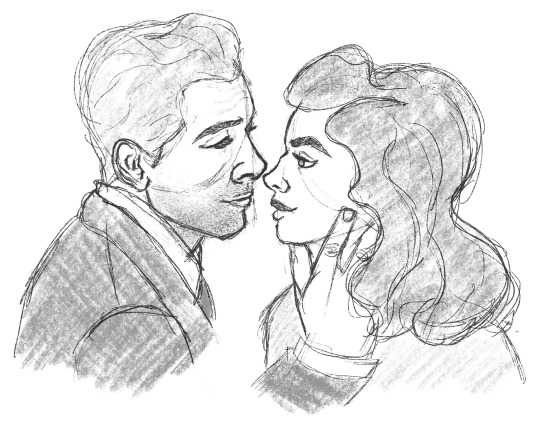
Thank you if you read this far! I’m already late with this so if anyone else wants to be late with me please feel free to consider yourself tagged!
#dragon age: inquisition#dragon age#cullen rutherford#cullen x inquisitor#cullen x trevelyan#wip wednesday#the fact that they are bickering here is not a spoiler#because that is all they do#incessant bickering#all fic#seriously#I don't know how to post writing stuff on tumblr helpppp#I'm nervous#my writing#drawing is based on bogart & bacall#not the first of my forays into how do you make cullen look like cullen???#I retreat defeated once more#hence why I will never finish this#because WHO IS THAT?
27 notes
·
View notes
Photo
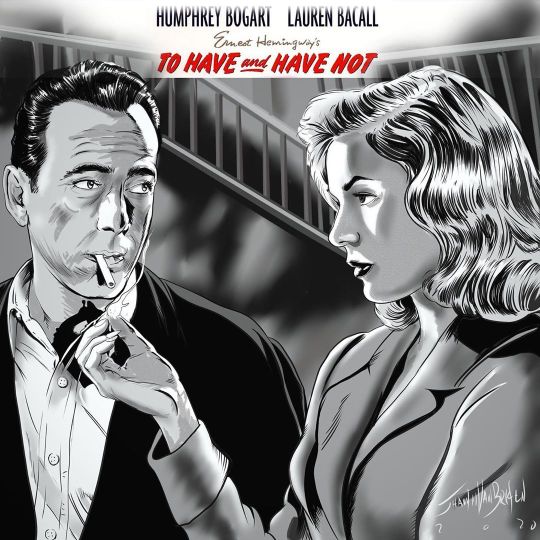
To Have and Have Not is a 1944 American romance-war-adventure film directed by Howard Hawks, loosely based on Ernest Hemingway's 1937 novel of the same name. It stars Humphrey Bogart, Walter Brennan and Lauren Bacall; it also features Dolores Moran, Hoagy Carmichael, Sheldon Leonard, Dan Seymour, and Marcel Dalio. The plot centers on the romance between a freelancing fisherman in Martinique and a beautiful American drifter, which is complicated by the growing French resistance in Vichy France. Ernest Hemingway and Howard Hawks were close friends and, on a fishing trip, Hawks told Hemingway, who was reluctant to go into screenwriting, that Hemingway could make a great movie from his worst book, which Hawks admitted was To Have and Have Not. Jules Furthman wrote the first screenplay, which was set in Cuba like the novel. However, the screenplay was altered to be set in Martinique instead of Cuba because the portrayal of Cuba's government was believed to be in violation of the United States' Good Neighbor policy with Latin American countries. Hawks's other good friend, William Faulkner, was the main contributor to the screenplay, including and following the revisions. Because of the contributions from both Hemingway and Faulkner, the film represents the only film story on which two winners of the Nobel Prize of Literature worked. Filming began on February 29, 1944, while Faulkner continued to work on the script, and ended on May 10. This is the latest in my exploration of Clip Studio Paint Pro. Inked entirely with the 'Real G-Pen' tool and colors with the paint tools. #clipstudio #digitalart #art #clipstudiopaint #drawing #illustration #filmnoir #artist #digital #sketch #artwork #duoshade #digitaldrawing #draw #artistsoninstagram #wacom #digitalillustration #instaart #digitalpainting #manga #darkpassage #characterdesign #myart #doodle #comics #originalcharacter #illustrator #painting #laurenbacall #shawnvanbriesen (at Brentwood) https://www.instagram.com/p/CB_jizOAocD/?igshid=16fay9rck33g9
#clipstudio#digitalart#art#clipstudiopaint#drawing#illustration#filmnoir#artist#digital#sketch#artwork#duoshade#digitaldrawing#draw#artistsoninstagram#wacom#digitalillustration#instaart#digitalpainting#manga#darkpassage#characterdesign#myart#doodle#comics#originalcharacter#illustrator#painting#laurenbacall#shawnvanbriesen
6 notes
·
View notes
Text
Today: Watched Dark Passage (1947) at last. Actually liked it. Bogart and Bacall's chemistry is palpable. Preferred the first half to the second, in which it becomes more rote, procedural. The first half was very - first-person character playing a video game. We see everything from Vincent Parry's perspective, in a bid to avoid showing Bogart's face. As such, characters are always looking into the camera. It's not a fourth wall break, though - but rather contributes to the sense of seeing from or through Parry's eyes. That's fresh, and really rather Blair Witch or other handheld documentary style. The film switches once Parry gets his face-change and becomes more conventional, the camerawork and cinematography becomes more 'normal' - to me returning to a more boring sort of film experience. The pacing as such sags a little in the second half of the film, which is a shame because that's when Bogart really 'appears', so to speak. Bacall also somewhat disappears in the later half of the film, while Parry goes off to find the murderer and is confronted by a small-time crook who tries to blackmail him, which is when the film really starts to drag somewhat. The best part of the film is Bogart and Bacall's chemistry, which is an interesting realisation considering I'd avoided watching their films together because I was roundly untaken by them in The Big Sleep, which I like less than this, though on the whole it is the better film. I think what's swayed me is the interesting manner in which it was filmed in the first half, plus the hallucinogenic fugue Parry experiences during the facial operation, which reminded me very much of Hannibal's kaleidoscopic montages, and also which seemed rather Lynchian. Everything else about the plot and the way it's handled needs to be taken with quite a bit of suspension of disbelief, but it's also gladly suspended in order to spend more time seeing Bogart and Bacall interact. Agnes Moorehead is also very good; the film really is carried by the calibre of its actors more so than the writing. For a noir, it's oddly bright - there are a number of daytime scenes, mostly of Parry, Bogart's character, moving around the city. In fact, I believe there are more daylight scenes than night, or in darkness. Nearly all the major scenes occur in broad daylight - Parry's initial escape from the prison on a truck; his initial hitching a ride where he first meets the to-be blackmailer; Irene, Bacall's character, picking him up; the drive back to San Francisco; Parry crossing the city to get back to Irene's apartment; Parry's confrontation with the blackmailer, from the drive out to their tussle somewhere near or under the Golden Gate Bridge; Parry's confrontation with Madge, who falls out a window to her death in daylight; and Parry's subsequent escape down the building via fire escapes. The only notable night scenes are the ones in the taxi cab, the face surgery in the doctor's office, Parry's meeting George in his apartment, the confrontation and escape from a police officer after he leaves Irene for presumably the last time, and lastly his leaving San Fran on a bus to Arizona. San Francisco is a lovely backdrop, but never becomes a character or pulls you in as a place the way The Third Man's Vienna does - hard not to draw comparisons as it's the last film I saw, and just last night. Interestingly, there's a happy ending, with Bogart and Bacall's characters meeting up again and swept into each other's arms in Peru, which, incidentally, felt a bit Casablanca-esque. All other characters pale away before these two; seem peripheral, though Parry's friend, George, is quite arresting in his screentime from Parry's point of view before he is knocked off relatively early on. But what does one expect? The film is about Bogart and Bacall's characters and their interaction. If based only on personal feeling, I like(d) this film better than The Big Sleep, but on merit, the latter wins out.
2 notes
·
View notes
Text
Sammy Davis Jr.




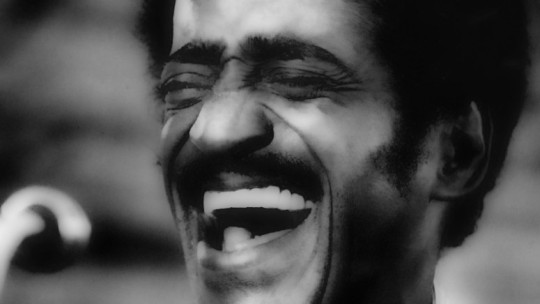
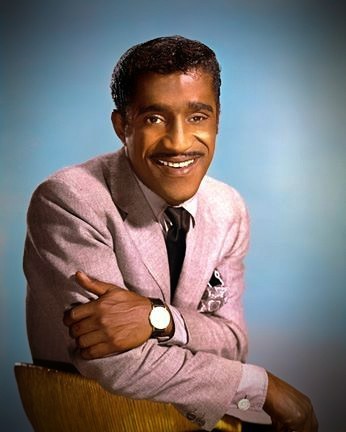
Samuel George "Sammy" Davis Jr. (December 8, 1925 – May 16, 1990) was an American entertainer. Primarily a dancer and singer, he was also an actor of stage and screen, comedian, musician, and impressionist, noted for his impersonations of actors, musicians and other celebrities. At the age of 3, Davis began his career in vaudeville with his father and Will Mastin as the Will Mastin Trio, which toured nationally. After military service, Davis returned to the trio. Davis became an overnight sensation following a nightclub performance at Ciro's (in West Hollywood) after the 1951 Academy Awards. With the trio, he became a recording artist. In 1954, he lost his left eye in a car accident, and several years later, he converted to Judaism.
Davis's film career began as a child in 1933. In 1960, he appeared in the Rat Pack film Ocean's 11. After a starring role on Broadway in 1956's Mr Wonderful, he returned to the stage in 1964's Golden Boy. In 1966 he had his own TV variety show, titled The Sammy Davis Jr. Show. Davis's career slowed in the late 1960s, but he had a hit record with "The Candy Man" in 1972 and became a star in Las Vegas, earning him the nickname "Mister Show Business".
Davis was a victim of racism throughout his life, particularly during the pre-Civil Rights era, and was a large financial supporter of the Civil Rights movement. Davis had a complex relationship with the black community, and drew criticism after physically embracing President Richard Nixon in 1972. One day on a golf course with Jack Benny, he was asked what his handicap was. "Handicap?" he asked. "Talk about handicap. I'm a one-eyed Negro Jew." This was to become a signature comment, recounted in his autobiography, and in countless articles.
After reuniting with Sinatra and Dean Martin in 1987, Davis toured with them and Liza Minnelli internationally, before he died of throat cancer in 1990. He died in debt to the Internal Revenue Service, and his estate was the subject of legal battles.
Davis was awarded the Spingarn Medal by the NAACP and was nominated for a Golden Globe Award and an Emmy Award for his television performances. He was the recipient of the Kennedy Center Honors in 1987, and in 2001, he was posthumously awarded the Grammy Lifetime Achievement Award.
Early life
Samuel George Davis Jr. was born on December 8, 1925, in the Harlem section of Manhattan in New York City, the son of entertainer and stage performer, Sammy Davis Sr., an African-American entertainer, and Elvera Sanchez, an Afro-Cuban tap dancer. During his lifetime, Davis stated that his mother was Puerto Rican and born in San Juan. However, in the 2003 biography In Black and White, author Wil Haygood writes that Davis's mother was born in New York City to parents of Cuban, Afro-Cuban, and African-American descent, and that Davis claimed he was Puerto Rican because he feared anti-Cuban backlash would hurt his record sales.
Davis's parents were vaudeville dancers. As an infant, he was reared by his paternal grandmother. When he was 3 years old, his parents separated. His father, not wanting to lose custody of his son, took him on tour.
Davis learned to dance from his father and his "uncle" Will Mastin, who led the dance troupe his father worked for. Davis joined the act as a child and they became the Will Mastin Trio. Throughout his career, Davis included the Will Mastin Trio in his billing. Mastin and his father shielded him from racism. Snubs were explained as jealousy, for instance. When Davis served in the United States Army during World War II, however, he was confronted by strong racial prejudice. He later said: "Overnight the world looked different. It wasn't one color any more. I could see the protection I'd gotten all my life from my father and Will. I appreciated their loving hope that I'd never need to know about prejudice and hate, but they were wrong. It was as if I'd walked through a swinging door for 18 years, a door which they had always secretly held open." At age 7 Davis played the title role in the film Rufus Jones for President, in which he sang and danced with Ethel Waters Davis lived for several years in Boston's South End, and reminisced years later about "hoofing and singing" at Izzy Ort's Bar & Grille.
Career
During service in World War II, the Army assigned Davis to an integrated entertainment Special Services unit and he found that the spotlight lessened the prejudice. Even prejudiced white men admired and respected his performances. "My talent was the weapon, the power, the way for me to fight. It was the one way I might hope to affect a man's thinking," he said.
After his discharge, Davis rejoined the family dance act, which played at clubs around Portland, Oregon. He also recorded blues songs for Capitol Records in 1949, under the pseudonyms Shorty Muggins and Charlie Green.
On March 23, 1951, the Will Mastin Trio appeared at Ciro's as the opening act for headliner Janis Paige. They were only to perform for 20 minutes but the reaction from the celebrity-filled crowd was so enthusiastic, especially when Davis launched into his impressions, that they performed for nearly an hour, and Paige insisted the order of the show be flipped.
He began to achieve success on his own and was singled out for praise by critics, releasing several albums. This led to Davis being hired to sing the title track for the Universal Pictures film Six Bridges to Cross in 1954, and later to his starring role in the Broadway play Mr. Wonderful in 1956.
In 1959, Davis became a member of the Rat Pack, led by his friend Frank Sinatra, which included fellow performers Dean Martin, Joey Bishop, and Peter Lawford, a brother-in-law of John F. Kennedy. Initially, Sinatra called the gathering "the Clan", but Davis voiced his opposition, saying that it reminded people of the Ku Klux Klan. Sinatra renamed the group "the Summit", but the media referred to them as the Rat Pack, the name of its earlier incarnation led by Humphrey Bogart and Lauren Bacall. The group made several movies together, including the original version of Ocean's 11 (1960), Sergeants 3 (1962), and Robin and the 7 Hoods (1964), as well as many joint stage appearances in Las Vegas and elsewhere.
Davis was a headliner at The Frontier Casino in Las Vegas, but he was required (as were all black performers in the 1950s) to lodge in a rooming house on the west side of the city, instead of in the hotels as his white colleagues did. No dressing rooms were provided for black performers, and they had to wait outside by the swimming pool between acts. Davis and other black artists could entertain, but could not stay at the hotels where they performed, gamble in the casinos, or dine or drink in the hotel restaurants and bars. Davis later refused to work at places which practiced racial segregation.
In 1964, Davis was starring in Golden Boy at night and shooting his own New York-based afternoon talk show during the day. When he could get a day off from the theater, he would be recording new songs in the studio, or performing live, often at charity benefits as far away as Miami, Chicago, and Las Vegas, or doing television variety specials in Los Angeles. Davis knew he was cheating his family of his company, but he could not help himself; as he later said, he was incapable of standing still.
Although he was still a draw in Las Vegas, Davis's musical career had sputtered by the late 1960s, although he had a No. 11 hit (#1 on the Easy Listening singles chart) with "I've Gotta Be Me" in 1969. His effort to update his sound and reconnect with younger people resulted in his signing with the Motown record label. Though his deal with them to have his own label with the company fell through, Sammy had an unexpected #1 hit with "The Candy Man" after he signed with MGM Records in 1972. Although he did not particularly care for the song and was chagrined that he was now best known for it, Davis made the most of his opportunity and revitalized his career. Although he enjoyed no more Top 40 hits, he did enjoy popularity with his 1976 performance of the theme song from the Baretta television series, "Baretta's Theme (Keep Your Eye on the Sparrow)" (1975–1978), which was released as a single (20th Century Records 2282). He occasionally landed television and film parts, including major parts on the television show The Rifleman on two different episodes, and cameos on I Dream of Jeannie, All in the Family (during which he famously kisses Archie Bunker (Carroll O'Connor) on the cheek) and, with wife Altovise Davis, on Charlie's Angels. In the 1970s, he appeared in commercials in Japan for Suntory whiskey.
On December 11, 1967, NBC broadcast a musical-variety special titled Movin' with Nancy. In addition to the Emmy Award-winning musical performances, the show is notable for Nancy Sinatra, daughter of Frank Sinatra, and Sammy Davis Jr. greeting each other with a kiss, one of the first black-white kisses in U.S. television history.
Davis had a friendship with Elvis Presley in the late 1960s, as they both were top-draw acts in Vegas at the same time. Davis was in many ways just as reclusive during his hotel gigs as Elvis, holding parties mainly in his penthouse suite, and Elvis went to them occasionally. Davis sang a version of Presley's song "In the Ghetto" and made a cameo appearance in Presley's concert film Elvis: That's the Way It Is. One year later, he made a cameo appearance in the James Bond film Diamonds Are Forever, but the scene was cut.
In Japan, Davis appeared in television commercials for coffee, and in the United States, he joined Sinatra and Martin in a radio commercial for a Chicago car dealership.
On May 27–28, 1973, Davis hosted (with Monty Hall) the first annual, 20-hour Highway Safety Foundation telethon. Guests included Muhammad Ali, Paul Anka, Jack Barry, Dr. Joyce Brothers, Ray Charles, Dick Clark, Roy Clark, Howard Cosell, Ossie Davis, Ruby Dee, Joe Franklin, Cliff Gorman, Richie Havens, Danny Kaye, Jerry Lewis, Hal Linden, Rich Little, Butterfly McQueen, Minnie Pearl, Boots Randolph, Tex Ritter, Phil Rizzuto, The Rockettes, Nipsey Russell, Sally Struthers, Mel Tillis, Ben Vereen, Lawrence Welk, and many more. It was a financial disaster. The total amount of pledges was $1.2 million. Actual pledges received were $525,000.
Davis was a fan of daytime soap operas, particularly the shows produced by the American Broadcasting Company. This led to a cameo appearance on General Hospital and a recurring role as character Chip Warren on One Life to Live, for which he received a Daytime Emmy Award nomination in 1980. He was also a game show fan, appearing on the ABC version of Family Feud in 1979. He appeared on Tattletales with his third wife, Altovise Davis, in the 1970s. He made a cameo during an episode of the NBC version of Card Sharks in 1981.
In addition to American soaps, he was also a huge fan of the Australian show Prisoner: Cell Block H. Davis wanted to make an appearance in Prisoner, but the show ended (in 1986) before this could be arranged.
Davis was an avid photographer who enjoyed shooting pictures of family and acquaintances. His body of work was detailed in a 2007 book by Burt Boyar, named Photo by Sammy Davis, Jr. "Jerry [Lewis] gave me my first important camera, my first 35 millimeter, during the Ciro's period, early '50s," Boyar quotes Davis. "And he hooked me." Davis used a medium format camera later on to capture images. Again quoting Davis, "Nobody interrupts a man taking a picture to ask ... 'What's that nigger doin' here?'" His catalog includes rare photos of his father dancing onstage as part of the Will Mastin Trio and intimate snapshots of close friends Jerry Lewis, Dean Martin, Frank Sinatra, James Dean, Nat "King" Cole, and Marilyn Monroe. His political affiliations also were represented, in his images of Robert Kennedy, Jackie Kennedy, and Martin Luther King Jr. His most revealing work comes in photographs of wife May Britt and their three children, Tracey, Jeff and Mark.
Davis was an enthusiastic shooter and gun owner. He participated in fast-draw competitions; Johnny Cash recalled that Davis was said to be capable of drawing and firing a Colt Single Action Army revolver in less than a quarter of a second. Davis was skilled at fast and fancy gunspinning, and appeared on television variety shows showing off this skill. He also demonstrated gunspinning to Mark on The Rifleman in "Two Ounces of Tin." He appeared in Western films and as a guest star on several "Golden Age" television Westerns.
Personal life
Car accident and conversion to Judaism
Davis nearly died in an automobile accident on November 19, 1954, in San Bernardino, California, as he was making a return trip from Las Vegas to Los Angeles. In 1953, he had struck up a friendship with comedian and host Eddie Cantor, who gave him a mezuzah. Instead of putting it by his door, as a traditional blessing, Davis would wear it around his neck as a good luck charm. The only time he forgot it was the night of the accident. The accident occurred at a fork in U.S. Route 66 at Cajon Boulevard and Kendall Drive (34.2072°N 117.3855°W / 34.2072; -117.3855). Davis lost his left eye to the bullet-shaped horn button (a standard feature in 1954 and 1955 Cadillacs) as a result. His friend, actor Jeff Chandler, said he would give one of his own eyes if it would keep Davis from total blindness. Davis wore an eye patch for at least six months following the accident. He was featured with the patch on the cover of his debut album and appeared on What's My Line? wearing the patch (March 13, 1955). Later, he was fitted for a glass eye, which he wore for the rest of his life.
While in San Bernardino's Community Hospital, Cantor told him about the similarities between the Jewish and black cultures. Prompted by this conversation, Davis—who was born to a Catholic mother and Protestant father—began studying the history of Jews. He formally converted to Judaism several years later, in 1961. One passage from his readings (from the book A History of The Jewsby Abram L. Sachar), describing the endurance of the Jewish people, intrigued him in particular: "The Jews would not die. Three millennia of prophetic teaching had given them an unwavering spirit of resignation and had created in them a will to live which no disaster could crush." The accident marked a turning point in Davis's career, taking him from a well-known entertainer to a national celebrity.
Marriages
In 1957, Davis was involved with Kim Novak, a young actress under contract to Columbia Pictures. The head of Columbia studio, Harry Cohn, was worried about the negative effect this would have on the studio because of the prevailing taboo against miscegenation. He called his friend, mobster John Roselli, who was asked to tell Davis that he had to stop the affair with Novak. Roselli arranged for Davis to be kidnapped for a few hours to throw a scare into him. His hastily arranged and soon-dissolved (after nine months) marriage to black dancer Loray White in 1958 was an attempt to quiet the controversy. In a 2014 BBC documentary, it was disclosed that Cohn arranged for Davis to be threatened with having his other eye put out or his leg broken if he did not marry a black woman within 48 hours. At his wedding celebration he became so inebriated that his friend, Arthur Silber, put him to bed. Upon checking later, Silber caught him holding a loaded pistol to his head. The marriage to Loray White was never consummated, Davis having offered to pay her $10,000 to enter into a sham marriage.
In 1960, Davis caused controversy again when he married white Swedish-born actress May Britt. Davis received hate mail while starring in the Broadway adaptation of Golden Boy during 1964–1966 (for which he received a Tony Award nomination for Best Actor). At the time Davis appeared in the play, interracial marriages were forbidden by law in 31 states (but were legal in New York), and only in 1967 were those laws ruled unconstitutional by the Supreme Court of the United States. Davis and Britt had one daughter Tracey and adopted two sons. Davis performed almost continuously and spent little time with his wife. They divorced in 1968, after Davis admitted to having had an affair with singer Lola Falana. That year, Davis started dating Altovise Gore, a dancer in Golden Boy. They were married on May 11, 1970, by the Reverend Jesse Jackson. Kathy McKee replaced Altovise in Davis's nightclub act. They adopted a son, Manny, in 1989. Davis and Altovise remained married until his death in 1990.
Political beliefs
Davis was a registered Democrat and supported John F. Kennedy's 1960 election campaign as well as Robert F. Kennedy's 1968 campaign.
However, he became a close friend to President Richard Nixon and publicly endorsed him at the 1972 Republican National Convention. Davis also made a USO tour to South Vietnam at Nixon's request. Previously, Davis had won Nixon's respect with his participation in the Civil Rights Movement. Nixon invited Davis and his wife, Altovise, to sleep in the White House in 1973, the first time African Americans were invited to do so. The Davises spent the night in the Queens' Bedroom.
Davis was a long-time donor to the Reverend Jesse Jackson's Operation PUSH organization. Jackson also performed Davis's wedding.
Cancer and death
In August 1989, doctors found a tumor in Davis' throat. Davis died in Beverly Hills, California, on May 16, 1990, aged 64, of complications from throat cancer. Earlier, when he was told that surgery (laryngectomy) offered him the best chance of survival, Davis replied he would rather keep his voice than have a part of his throat removed; he subsequently was treated with a combination of chemotherapy and radiation. However, a few weeks prior to his death, his entire larynx was removed during surgery. He was interred in the Forest Lawn Memorial Park in the Garden of Honor, Lot 5774, Space 1 in Glendale, California, next to his father and Will Mastin.
On May 18, 1990, two days after Davis's death, the neon lights of the Las Vegas Strip were darkened for 10 minutes as a tribute to him. He was survived by his wife, his daughter, his sons, his sister, his mother, his grandmother, and two grandchildren.
Legacy
Davis was portrayed by Don Cheadle in the HBO film The Rat Pack, a television film about the group of entertainers. Cheadle won a Golden Globe Award for his performance.
Comedian Eddie Griffin has made his impersonation of Davis a major part of his act.
On later episodes of The Cosby Show, Cliff Huxtable (Bill Cosby) wore an "SDjr" pin as a tribute to Davis, who, in its 5th season, made a guest appearance in the episode "No Way, Baby".
On Saturday Night Live, Davis has been portrayed by Garrett Morris, Eddie Murphy, Billy Crystal and Tim Meadows.
Davis was portrayed on the popular sketch comedy show In Living Color by Tommy Davidson, notably a parody of the film Ghost, in which the ghost of Davis enlists the help of Whoopi Goldberg to communicate with his wife.
David Raynr portrayed Davis in the miniseries Sinatra, a television film about the life of Frank Sinatra.
Davis was portrayed by Keith Powell in an episode of 30 Rock entitled "Subway Hero".
In the 1993 film Wayne's World 2, Tim Meadows portrays Davis in the dream sequence with Michael A. Nickles as Jim Morrison.
He was portrayed by Paul Sharma in the 2003 West End production Rat Pack Confidential.
In September 2009, the musical Sammy: Once in a Lifetime premiered at the Old Globe Theatre in San Diego with book, music and lyrics by Leslie Bricusse, and additional songs by Bricusse and Anthony Newley. The title role was played by Broadway Tony Award nominee Obba Babatundé.
Davis was mentioned in British singer Amy Winehouse's album Back to Black on the song "Me and Mr. Jones". The lyrics are as follows: "Aside from Sammy you're my best black Jew."
A black and white portrait of Davis, drawn by Jim Blanchard, adorns the cover of avant-garde rock band Oxbow's second album King of the Jews.
Midwest radio personality Kevin Matthews impersonated Sammy Davis Jr. many times on his radio show.
Comedian Jim Carrey has portrayed Davis on stage, in the film Copper Mountain, and in a stand-up routine.
Comedian Billy Crystal has portrayed Sammy Davis Jr. in his stand-up routine and at the Oscars.
"Sammy" is a song dedicated to Davis on the 1997 Gwar album Carnival of Chaos.
In the novel and its film adaptation Everything Is Illuminated, the grandfather's seeing-eye dog is named "Sammy Davis Jr. Jr".
Actor Phaldut Sharma created the comedy web-series I Gotta Be Me, following a frustrated soap-star as he performs as Sammy in a Rat Pack tribute show.
Discography
Honors and awards
Grammy AwardsEmmy AwardsOther honors
Filmography
Stage
Mr. Wonderful (1957), musical
Golden Boy (1964), musical – Tony Nomination for Best Actor in a Musical
Sammy (1974), special performance featuring Davis with the Nicholas Brothers
Stop the World – I Want to Get Off (1978) musical revival
TV
General Electric Theater – "The Patsy" (1960) Season 8 Episode 21
Lawman – episode Blue Boss and Willie Shay" (1961)
The Dick Powell Show" - episode "The Legend" (1962)
Hennesey – episode "Tight Quarters" (1962)
The Rifleman – 2 episodes "Two Ounces of Tin (#4.21)" (February 19, 1962) and "The Most Amazing Man (#5.9)" (November 27, 1962)
77 Sunset Strip – episode "The Gang's All Here" (1962)
Ben Casey – episode "Allie" (1963)
The Patty Duke Show – episode "Will the Real Sammy Davis Please Hang Up?" (1965)
The Wild Wild West – episode "The Night of the Returning Dead" (October 14, 1966)
Batman - "The Clock King's Crazy Crimes" (1966)
I Dream of Jeannie – episode "The Greatest Entertainer in the World" (1967)
The Mod Squad - episode "Keep the Faith Baby" (1969)
The Beverly Hillbillies - episode Manhattan Hillbilies (1969)
The Name of the Game – episode "I Love You, Billy Baker" (1970)
Here's Lucy (1970)
All in the Family – episode "Sammy's Visit" (1972)
Chico and the Man - episode "Sammy Stops In" (1975)
The Carol Burnett Show (1975)
Sammy and Company - host/performer (1975)
Charlie's Angels – episode "Sammy Davis, Jr. Kidnap Caper" (1977)
Sanford (TV series) – episodes "Dinner and George's"(cameo) and "The Benefit" (1980)
Archie Bunker's Place – episode "The Return of Sammy" (1980)
The Jeffersons episode "What Makes Sammy Run?" (1984)
Fantasy Island episode "Mr. Bojangles and the Dancer/Deuces are Wild" (1984)
Gimme a Break! – episode "The Lookalike" (1985)
Hunter – episode "Ring of Honor" (1989)
The Cosby Show – episode "No Way, Baby" (1989)
Wikipedia
7 notes
·
View notes